Legacy Items No Longer Enchantable
The next Beta build will bring in a hotly debated change to the game. Items that were found prior to 2.0.1 will be considered Legacy and will not be Enchantable.
Originally Posted by Blizzard (Blue Tracker / Official Forums)
Currently, items enchant values that are equivalent to the item's level. However, there's a major change coming in the next build, and this thread was the most appropriate to communicate it in given the topic at hand.
In the next Beta patch, Legacy items (or items that drop prior to Patch 2.0.1) will no longer be able to be enchanted. This was a decision we ultimately made because certain Legacy items, when enchanted, became disproportionately strong compared to new items, which isn't the intent.
However, there's an interesting "bug," if you'd like to call it, that will result from this change in the next Beta patch - all items gained up until the patch will no longer be able to be enchanted. This is an artifact of the fix implementation, and we felt it prudent to communicate this as soon as we could for those of you in the Beta. All items that drop in Patch 2.0.1 and forward will be able to be enchanted, so this shouldn't be an issue as we move into the live patch and onward to the expansion launch.
*Edited in some additional clarification*
Stash Size Increased
From the next Beta/PTR build players will find they have one more stash tab available for purchase!
Originally Posted by Blizzard (Blue Tracker / Official Forums)
There have been a few changes we've made to alleviate stash overflow, the biggest of which has been condensing down crafting materials into two tiers and increasing the stacks of many other commonly hoarded items. Where there was once ten different materials for 1-60 crafting (not counting Pages and Tomes), now there's only five. Gem and Material stack sizes have been increased fairly drastically as well, stacking up to 1000, and Pages and Tomes have been removed from the game.
However, we do see a need with many of the additional crafting materials and items added in Reaper of Souls to add an additional Stash tab. In the next Beta patch, a new Stash tab will be available for purchase for players in the Beta. This tab will unlock in a very similar manner as previous tabs, and require purchasing the initial tab and additional 14 slot expansions over time. When the time comes for the expansion launch, this Stash tab will require the Reaper of Souls expansion to access.
1 extra stash tab is a nice small addition and it's very welcome, but now I'm going to approach the mouth of the lion with and ask for 2 more and hoping to not get bittenNOM NOM NOM.
"First Look" Blogs
A player on the official forums found a blog post that is a few months old and discovered that some information posted back then has now become wrong. Here are the interesting details.
Originally Posted by Blizzard (Blue Tracker / Official Forums)
The blog in question is a First Look blog, as DeadRu has mentioned. This means it was intended to provide an inside look at the current development state and functionality of the Mystic, at the time it was written.
We've always said that details can and likely will change over the course of development. This happens to be one of those times.
Originally, we did want to give players this opportunity. We didn't want to invalidate or take away player options. However, it became increasingly evident through testing that artifacts of the old itemization system could become overpowered through enchanting, especially so with certain items. This is why testing is so important, and it was a decision that took some time to make.
I'd also like to throw out there that some players seem to think this means you can't enchant level 1-60 items at all, when that isn't true. Items gained prior to the 2.0.1 patch hitting the live servers will be unable to be enchanted. Anything you gain after the patch launches and before the expansion, however, are eligible to be enchanted.
Ah, so it's a case of "True at the time, untrue now"!As Nevalistis noted, the goal of each of the "first look" blogs we've published (there's been a few: the Mystic, Westmarch, Adventure Mode, and the Crusader) has been to provide players a first look at the development of certain features in Reaper of Souls. They're not wholesale previews; rather, they're a snapshot of what's being worked on. It's a way for us to include our community in the development process and feel involved -- or, at the very least, informed. Same can be said for all the posts we've made about the expansion, too.
Don't you guys think that maybe, just maybe, this policy of yours to dish out information that can be retracted at any point is a little problematic?
For the Mystic "first look" blog specifically, it never actually says that Legacy items can be enchanted. However, in the posts where we did state that Legacy items could be enchanted, we very likely prefaced the information with the caveat that the functionality is as of current design and/or was subject to change based on testing and additional development. We actually say this about most everything in Reaper of Souls -- to the point where some have lovingly mocked us for it -- as until something is shipped, it's subject to change. And even then, it's possible that we'll make adjustments to a feature that's gone live, if we feel it'll make the in-game experience better.
Getting back to your main point, though, the alternative would be not to communicate any information until development is 100% complete and those changes are already out the door. That's not a scenario we're super keen on, so it's highly unlikely that we'll shift our approach and not talk about future content. We want to share information with players during development cycles, and we want you to know what's coming. Not only does this give players the opportunity to provide feedback and be a part of the development process directly, but it also enables you to make informed decisions about the product itself. That last part is also very important to us.
I definitely understand where you're coming from, and why you're suggesting that we just never talk about upcoming content until is 100% certain. There are upside and downsides to everything, though. In this case, the downside of our approach is that when something is still in development, that thing is likely to go through multiple changes -- changes that may not always be favorable to you personally. The upside of our approach is you know we'll communicate those multiple changes to you, too. Our current approach allows for much more transparency, and (ideally) empowers you guys more than if we just didn't talk about anything at all.
PS - I think it's important to call out that, when it comes to content that's in development and not yet final, we don't always know that a change is needed until it's needed. Or that we're going to change something until we know that we're going to change something. By this I mean, when we share information with our players about something that's still in development (like how a feature works, for example), the information we share is always true when we communicate it. It's not like we're sharing stuff we already know is going to change before it ships. We just always provide that "subject to change" caveat, because we realize, with testing and feedback, changes may be required that we can't always anticipate.Hi lylirraHi Doctor.
I just want to point out that as a community manager it is your responsibility to communicate between players and game developers. You want feedback on your changes, well look at the forum and the posts people have about your current decision on Not allowing legacy enchant, see how many people hate that idea. It's a vast majority of us. Should you feedback that to the person who made that terrible decision in the first place? Thanks. I hope they change their mind on this, otherwise most of us will not be happy!To answer your question, yup we are actively passing on player feedback in response to this change to our developers.
Design a Legendary, Part 6: Weapon Texture, Model, and Paint
The entire process of creating the Shard of Hate has been documented and presented in a very visually pleasing way.
Originally Posted by Blizzard (Blue Tracker/ Official Forums)
As we've published our different Design a Legendary articles, one request we've seen over and over again is to share more behind-the-scenes information about the visual design process in Diablo III. What's involved in creating an item's appearance? How long does it normally take? Who works on item art: is it one person, or many? Why is Aaron Gaines so amazing? And so forth.
Well, we're happy to oblige! Read on below for a step-by-step process on how our community Legendary sword was brought to life, as well as a Q&A with Aaron himself.
From Concept to Animation: The Life Cycle of a Legendary
This whole process started with an initial piece concept art. Knowing that the community had selected a one-handed, Mephisto-themed sword for the Design a Legendary project, Aaron began sketching a first draft in Photoshop.
Next step: Iteration! After the intial concept was complete, Aaron created a second piece of concept art, also in Photoshop. This illustration would serve as the final concept piece and ultimately provide a visual basis for the in-game model. Before sketching this piece, Aaron made sure to pour over feedback from the community, making adjustments to the concept's design per player suggestions.
Once Aaron finished the final concept piece, he used the 2D illustration as a basis to begin sculpting a high-poly 3D model. This work was done in zBrush.
After completing the high poly sculpt in zBrush, Aaron created a low poly model of the sword in Maya. He then baked (or applied) the high poly sword texture onto the low poly model in order to create a detailed, but low poly version of the item that would be fit for use in the game. In the image on the right, you can see both the original low poly model (left) and low poly model with the applied high poly texture (right).
From there, Aaron "unwrapped" the 3D model to ready it for painting in Photoshop.
For those who aren't familiar with 3D graphics, the way a particular texture is wrapped around a model is determined by mapping coordinates (often called UVW coordinates). Unwrapping is the process of laying out those coordinates flat so that texture painting can be done. To provide a very simple analogy, think of unwrapping a 3D model like breaking down a packing box to its original folding pattern or taking a globe of the Earth and rolling it out into a two-dimensional map.
Unwrapping is an important step, as during this process the artist can adjust the UWV coordinates to minimize stretching and identify seams (or visible "folds"). Usually, the less stretching there is, the more seams there are, and vice-versa. It's all about balance! Thankfully, a clever artist can hide seams with a 3D paint -- which is exactly what Aaron did once the unwrapping process was complete.
Once the texture paint was done, Aaron passed the torch to Jill Harrington, a senior technical arist on the Diablo III development team. Jill is responsible for the adding the awesome smoke-and-lightning effect (and making sure it animates properly as your heroes rofflestomp everything in sight) seen in the screenshot below.
And there you go! The visual life cycle of Legendary, from concept (art) to animation. Pretty neat, huh?
Q&A with Aaron Gaines
If you're hankerin' for even more information about how items in Diablo III are created, you're in luck! It just so happens we had an opportunity to sit down with Aaron and ask him a few questions (i.e. we emailed him the questions because we're gamers and it's more efficient that way) about his role in the Design a Legendary project. Check it out!
Q. Tell us a bit about yourself and your position. What exactly does a 3D character artist do in Diablo III?
A character artist on Diablo III is a chimera of focused energies. Heroes, monsters, bosses, NPC’s, items, weapons, and armor are our bread and butter. Some of us do our own concepts, and some of us even have rigging, sfx, and scripting skills. My specialization is weapon design and creation.
Q. How many character artists are there are currently on the Diablo III development team who focus on item design? And how do you all decide who gets to work on which weapon?
Currently, there are six character artists, and each one of us has a unique style and personality. It’s a great environment to work in. We all learn from each other and help each other to become better at our craft. If a needed asset is tasked to the character department, we will see if anyone wants it specifically. It could also get added to a list and then divvied out to everyone, or to whoever has the time. But for the most part, if you really want to make something you get to make it.
Q. When approaching the visual design of an item in a game like Diablo III, where do you begin?
I could talk all day about what makes a Diablo III weapon a Diablo III weapon. I love making weapons. A while back, we came up with a rough style guide with that exact goal in mind; to give anyone working on an item some clear direction and understanding for their task. The main thing for me is to keep it in the realm of realistic, but still fantastical. We like to think of it as "low fantasy," whereas something like WoW is more high fantasy. Identifiable materials, themes, and strong, iconic silhouettes are a must for our camera angle. WoW has a very big, bulky, chunky design language that fits incredibly well in their world. For us, we need to be a bit more toned back, while keeping that epic Blizzard feel. It's a bit of a challenge, and I love doing it.
Q. Can you tell us a bit more about the whole visual design process? For example, for those of us who have never designed an item for a game, what are all the different stages involved in bringing something that to life?
Well, as in practically all game design, it never really goes exactly according to plan. Hah. Someone in design might have an idea first and write up some flavor text, for instance. Or someone will say "we need six new swords right now," and we have to scramble to get someone on concepts first then design where they go later.
In an ideal scenario, the design team will need some art for an item they need. The concept team or the character team will do some rough sketches first and then a more finished piece based on what we all decided was the best one. From there, it is tasked to a character artist and we model it, then paint it, then export it into our game using our tools, and then everyone says AWW YISS THAT'S AWSEOME. And we eat cake and celebrate.
Q. How long on average does it take to go from concept to creation for an in-game item (particularly a Legendary item) -- at least from the visual side of things?
Legendary items more often than not take a bit longer than standard items due to their super sweet nature. Usually anywhere from 1-2 days for a concept, and then 1-3 days for the creation. Helms and shoulder pads take longer because we have to manually fit them to all the classes, male and female. I'd say a week to be safe, but they’re often part of a group of items which has a longer deadline so it’s tough to really say exactly.
Q. So, for our Design a Legendary project, the community decided that we should make a Mephisto-themed one-handed sword. That's pretty exciting to me! Can you walk us through how you approached translating that information into the design of this particular weapon?
I started by being excited because I love Mephisto, and apparently, so does everyone else… which is awesome. After that it was a mix of successfully translating the idea of the item visually and then taking into consideration some of the awesome suggestions from the forum posts. I’m really happy how it turned out.
Q. What's your favorite part about this weapon?
My favorite part is the wickedness of the blade I think. It looks like the mouth of a tiger shark badly in need orthodontics… and I wouldn't want to get hit by it.
Q. What part of its design was the most challenging?
Making sure it was iconic enough and didn't get too busy. There is a lot of stuff going on in this sword. Picking the right things to be focal points and keeping other things as supporting visuals was the key to keep it in check so it doesn't look ridiculous.
Q. Any recommendations for aspiring artists out there?
The best advice I can give is to never stop believing in yourself, never stop absorbing inspirational material, and never stop doing art. Unless you're some sort of alien savant, you aren’t going to become a master overnight, so the old saying " practice makes perfect" very much applies.
Also know when to be finished. You can noodle away at tiny details of something forever, but you have to move on to the next piece to learn from the last piece.
Previous Design a Legendary Articles:
- Introducing: Design a Legendary
- Design a Legendary, Part 1: Choose Your Weapon Vote
- Design a Legendary, Part 1: Choose Your Weapon Results
- Design a Legendary, Part 2: Choose Your Theme Vote
- Design a Legendary, Part 2: Choose Your Theme Results
- Design a Legendary, Part 3: "Choose Your Power" Livestream Coming Soon
- Design a Legendary, Part 3: "Choose Your Power" Livestream Now Available
- Design a Legendary, Part 3: Choose Your Power Vote
- Design a Legendary, Part 3: Choose Your Power Results
- Design a Legendary, Part 4: Visual Design Progress
- Design a Legendary, Part 4: Updated Concept Art
- Design a Legendary, Part 5: Choose Your Name Vote
- Design a Legendary, Part 5: Choose Your Name Results
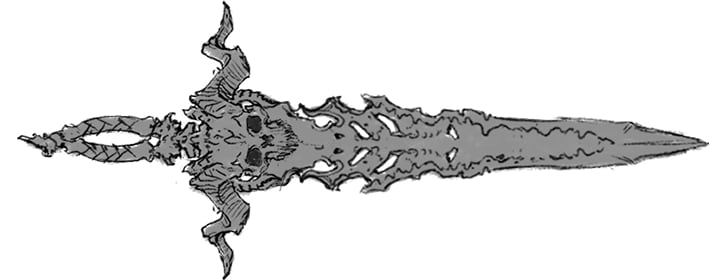


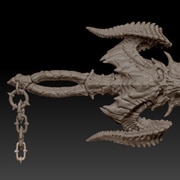
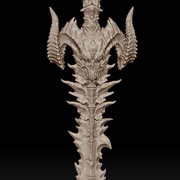
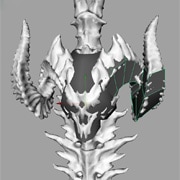
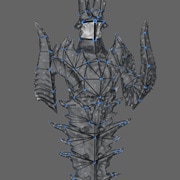

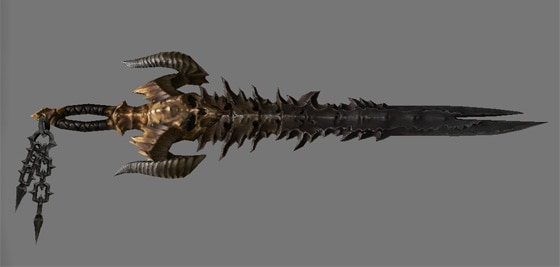
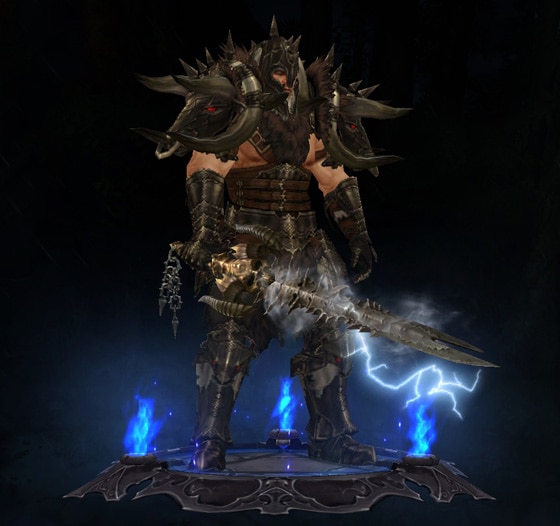
-
View User Profile
-
Send Message
Posted Feb 5, 2014What a weird world these people must live in; where your initial idea cannot be iterated upon.
-
View User Profile
-
Send Message
Posted Feb 6, 2014It's for the best - since new loot only has 4 primary affixes, really amazing items in the old system have an unfair advantage having 6. Primary stat values are inflated in RoS but crit/attack speed/etc aren't so much. The more quickly they can get everyone to ditch their old stuff, the better. I'm not sure why anyone would even want to hold on to the loot they already have from the very start of the expansion.
-
View User Profile
-
Send Message
Posted Feb 6, 2014-
View User Profile
-
Send Message
Posted Feb 6, 2014Most of the bugs on the ptr now is already fixed because the ptr/beta is a months old build according to Travis Day. So mid to late feb release is my guess
-
View User Profile
-
Send Message
Posted Feb 6, 2014